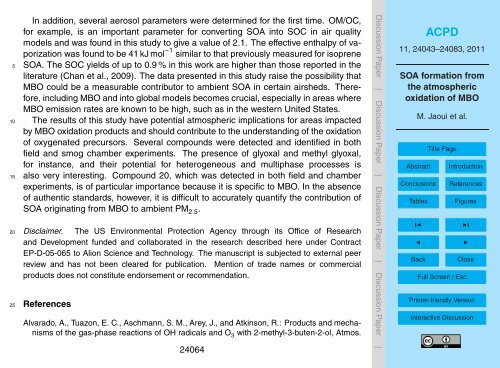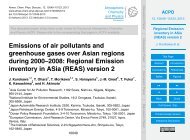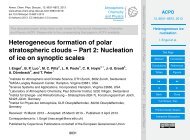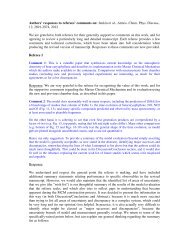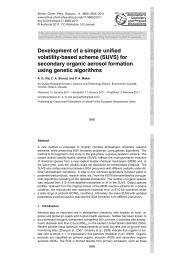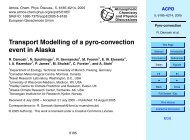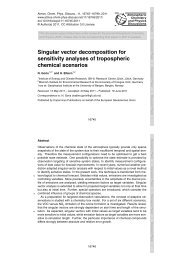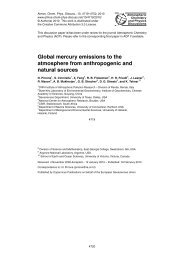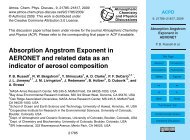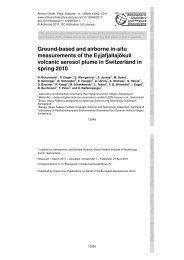SOA formation from the atmospheric oxidation of MBO - ACPD
SOA formation from the atmospheric oxidation of MBO - ACPD
SOA formation from the atmospheric oxidation of MBO - ACPD
You also want an ePaper? Increase the reach of your titles
YUMPU automatically turns print PDFs into web optimized ePapers that Google loves.
5<br />
10<br />
15<br />
20<br />
25<br />
In addition, several aerosol parameters were determined for <strong>the</strong> first time. OM/OC,<br />
for example, is an important parameter for converting <strong>SOA</strong> into SOC in air quality<br />
models and was found in this study to give a value <strong>of</strong> 2.1. The effective enthalpy <strong>of</strong> vaporization<br />
was found to be 41 kJ mol −1 similar to that previously measured for isoprene<br />
<strong>SOA</strong>. The SOC yields <strong>of</strong> up to 0.9 % in this work are higher than those reported in <strong>the</strong><br />
literature (Chan et al., 2009). The data presented in this study raise <strong>the</strong> possibility that<br />
<strong>MBO</strong> could be a measurable contributor to ambient <strong>SOA</strong> in certain airsheds. Therefore,<br />
including <strong>MBO</strong> and into global models becomes crucial, especially in areas where<br />
<strong>MBO</strong> emission rates are known to be high, such as in <strong>the</strong> western United States.<br />
The results <strong>of</strong> this study have potential <strong>atmospheric</strong> implications for areas impacted<br />
by <strong>MBO</strong> <strong>oxidation</strong> products and should contribute to <strong>the</strong> understanding <strong>of</strong> <strong>the</strong> <strong>oxidation</strong><br />
<strong>of</strong> oxygenated precursors. Several compounds were detected and identified in both<br />
field and smog chamber experiments. The presence <strong>of</strong> glyoxal and methyl glyoxal,<br />
for instance, and <strong>the</strong>ir potential for heterogeneous and multiphase processes is<br />
also very interesting. Compound 20, which was detected in both field and chamber<br />
experiments, is <strong>of</strong> particular importance because it is specific to <strong>MBO</strong>. In <strong>the</strong> absence<br />
<strong>of</strong> au<strong>the</strong>ntic standards, however, it is difficult to accurately quantify <strong>the</strong> contribution <strong>of</strong><br />
<strong>SOA</strong> originating <strong>from</strong> <strong>MBO</strong> to ambient PM 2.5.<br />
Disclaimer. The US Environmental Protection Agency through its Office <strong>of</strong> Research<br />
and Development funded and collaborated in <strong>the</strong> research described here under Contract<br />
EP-D-05-065 to Alion Science and Technology. The manuscript is subjected to external peer<br />
review and has not been cleared for publication. Mention <strong>of</strong> trade names or commercial<br />
products does not constitute endorsement or recommendation.<br />
References<br />
Alvarado, A., Tuazon, E. C., Aschmann, S. M., Arey, J., and Atkinson, R.: Products and mechanisms<br />
<strong>of</strong> <strong>the</strong> gas-phase reactions <strong>of</strong> OH radicals and O 3 with 2-methyl-3-buten-2-ol, Atmos.<br />
24064<br />
Discussion Paper | Discussion Paper | Discussion Paper | Discussion Paper |<br />
<strong>ACPD</strong><br />
11, 24043–24083, 2011<br />
<strong>SOA</strong> <strong>formation</strong> <strong>from</strong><br />
<strong>the</strong> <strong>atmospheric</strong><br />
<strong>oxidation</strong> <strong>of</strong> <strong>MBO</strong><br />
M. Jaoui et al.<br />
Title Page<br />
Abstract Introduction<br />
Conclusions References<br />
Tables Figures<br />
◭ ◮<br />
◭ ◮<br />
Back Close<br />
Full Screen / Esc<br />
Printer-friendly Version<br />
Interactive Discussion


